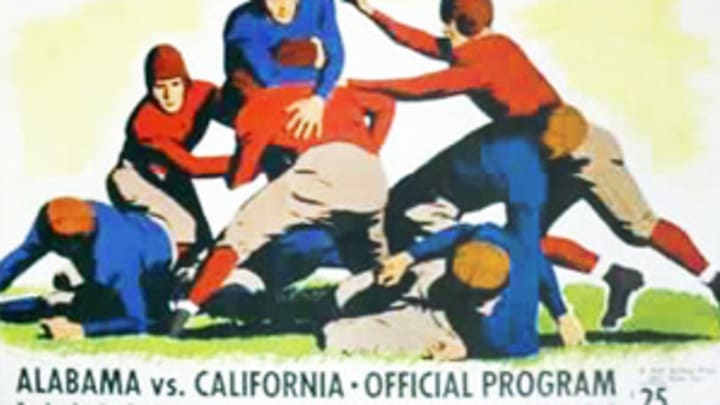What Does it Take to Beat Alabama in the Rose Bowl? A Perfect Thunderstorm

In this story:
When Alabama Crimson Tide fans look back on the 1937 team, many may not fully comprehend what happened at the end of the season.
On paper, the Crimson Tide was extremely successful. It had notched shutouts in five of its first six games. The team finished the regular season 9-0, including a perfect 6-0 mark in the Southeastern Conference, and had outscored opponents 225-33. Alabama boasted a Heisman Trophy candidate, and an All-American lineman.
The former was All-American running back Joe Kilgrow, who finished fifth in the voting. He was wrapping up an illustrious career during which the Crimson Tide had compiled a 23-3-2 record.
The latter was Leroy G. Monsky, Sr., who was honored with the Jacobs Trophy as the SEC's best blocker, and named an All-American while helping lead Alabama to the Rose Bowl. Head coach Frank Thomas and assistant Hank Crisp both called him “the smartest and best guard” they ever coached, and legendary sportswriter Grantland Rice dubbed him the best guard in the country:
“Leroy Monsky, amazingly fast for his size and power, was outstanding on both offense and defense and was a key man in the Alabama attack which specializes in the use of the guards. His fighting courage was the deciding factor in most of these games.”
But thing started to turn against the Crimson Tide even before it made it to Pasadena. To begin with, the early-season dominance all but vanished down the stretch in November as Sandy Sanford had to make a 41-yard field goal in the closing moments to seal a 9-6 victory at No. 19 Tulane. Alabama followed with a 7-0 victory over Georgia Tech (back then it was considered a rivalry game), and 9-7 at No. 12 Vanderbilt.
Subsequently, during a practice on the way to California, a lineman pulled the wrong way and collided with Monsky, who needed 25 stitches above his left eye. He played, but the incident foreshadowed the game, won by California, 13-0. It was the only loss Monsky experienced at Alabama.
“It was a heartbreaker,” he said. “I still try and blank it from my mind.”
The other part of the equation was Alabama played probably the best team in Cal history, known as the "Thunder Team" because of its hard-hitting nature.
The Bears shut out seven of eleven opponents, and outscored all opponents 214-33. They featured three players who have since been inducted into the College Football Hall of Fame: center Bob Herwig (inducted 1964), halfback Vic Bottari (1981),[and back Sam Chapman (1984), who went on to play Major League Baseball.
When Sports Illustrated picked a Pac-10 all-century team in 2001, Bottari was on it. He ran for 137 yards and two touchdowns in the game. Head coach Stub Allison also had three other All-Americans as well: end Perry Schwartz, guard Vard Stockton and quarterback John Meek.
Alabama threatened twice in the game, reaching the Cal 2- and 7-yard lines, but fumbled both times. They were part of eight Crimson Tide turnovers, four lost fumbles and four interceptions.
That was 86 years ago, the year that the Golden Gate Bridge opened, the Hindenburg burst into flames and crashed, and Amelia Earhart vanished on her attempted flight around the world. Cal hasn't been able to notch another win in the Rose Bowl since, and it's only been back four times, most recently in 1959.
This will (sort of) be Alabama's fourth return to Rose Bowl over the same time period, when it faces No. 1 Michigan in a College Football Playoff semifinal on Jan. 1. In the Crimson Tide's eight games associated with the Tournament of Roses, Cal remains the lone loss.
Parts of this story originally appeared in 100 Things Crimson Tide Fans Should Know and Do Before They Die.
This is the fifth story in a series about Alabama's history in the Rose Bowl as in prepares to face Michigan in the CFP semifinal on Jan. 1
“Stanford Made a Mistake in Scoring First; It Just Made Those Alabama Boys Mad”

Christopher Walsh is the founder and publisher of Alabama Crimson Tide On SI, which first published as BamaCentral in 2018, and is also the publisher of the Boston College, Missouri and Vanderbilt sites . He's covered the Crimson Tide since 2004 and is the author of 27 books including “100 Things Crimson Tide Fans Should Know and Do Before They Die” and “Nick Saban vs. College Football.” He's an eight-time honoree of Football Writers Association of America awards and three-time winner of the Herby Kirby Memorial Award, the Alabama Sports Writers Association’s highest writing honor for story of the year. In 2022, he was named one of the 50 Legends of the ASWA. Previous beats include the Green Bay Packers, Arizona Cardinals and Tampa Bay Buccaneers, along with Major League Baseball’s Arizona Diamondbacks. Originally from Minnesota and a graduate of the University of New Hampshire, he currently resides in Tuscaloosa.
Follow BamaCentral